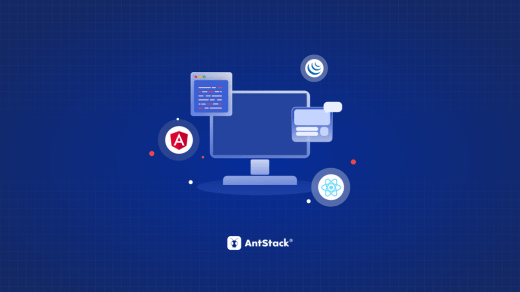Front-end frameworks are recognized as a collection of libraries, pivotal tools, and different pre-designed components. Such components are equipped with different reusable components, for CSS, JavaScript, and HTML, which the developers reuse in other projects.
The front-end frameworks play an integral role in streamlining the development process, thereby assuring a more app-like feeling and smooth transitions during user interactions. They are considered to be crucial tools that allow developers to create efficient and engaging digital experiences. Thus, they provide a helping hand to make the web app development process more organized, structured, and user-friendly. Now, we are going to talk about the best front-end frameworks for web development in 2024:
React.Js
React.js happens to be a well-renowned front-end framework to accomplish the success of full-stack web development projects. The presence of hassle-free UI components and robust integration capabilities allows individual developers and web development business organizations to utilize the JavaScript library.
It is equipped with an enriched components library, which offers powerful features to the developers, like server-side rendering, high-performance virtual DOM, and automated UI testing during serverless development. React.Js provides versatility, and thus, you can use it to create enterprise-level web solutions with dynamic user interfaces. Therefore, it offers quicker time to market without the need to compromise the code quality standards.
Vue.Js
It is another famous framework that comes with official routing, scoped CSS, and ready-made API for transitions. Vue’s benefits include detailed documentation that provides support for simple and complex apps. It is considered to be a suitable choice for projects that need flexibility over different stable components.
Angular.Js
It is another famous front-end framework in the full stack web development. Hence, it is regarded as an excellent option for serverless application in the web development companies. It provides a fantastic opportunity for developers to widen their HTML vocabulary. Thus, it helps to create complicated apps faster. Angular.Js functions as the effective bridge between the design departments and code to improve team collaboration. It decreases the code complexity with effective project management. It assures that the applications remain more maintainable.
Solid.js
It is considered a popular framework for serverless app and is earning a high reputation within the online community. It is supposed to be quicker than React. It features an extensive component lifecycle, which is ideal for scalable dashboards, apps, and building performance.
Preact
It is another worth mentioning front end framework, which offers a powerful feature of different features. It provides a suitable opportunity for developers to build feature-rich and complex apps. It provides an excellent option for the developers to mix and reuse the existing code with the components library. It helps to decrease the development time for the projects. This front-end framework is helpful in optimizing the code more efficiently. As it is integrated with the front-end libraries, you do not need to sacrifice the app’s scalability and performance.
Lit
It is regarded as a user-friendly, small front-end framework that provides outstanding performance. It functions as a functional reactive layer around different web component primitives. It helps migrate to native code from JS.
Svelte
It is another famous open-source front-end framework that boasts a lightning-quick response time and a compile-time approach that decreases the website size. Hence, it is regarded as an excellent choice for beginners and minor projects. The features of the front-end framework include minimal boilerplate, lightweight implementation, a ready-made reactive store, and hassle-free learning. The responsiveness and simplicity make it an excellent choice for different media-focused apps.
Ember.Js
It happens to be an open-source and powerful JavaScript library that boasts a massive user base. It offers valuable tutorials and guides, which are helpful to developers so that they can get the most out of the platform. It provides the ideal opportunity for developers to build interactive SPAs and complex user interfaces faster. Thus, it is helpful for developers to create websites using native features.
Qwik
Qwik is a promising framework that boasts a reusability model. It stands out in providing app loading performance and dev experience. It helps eradicate different challenges, like handling exit animations and understanding functions.
Choosing the right front-end framework for the business requires careful consideration of the core functionalities, popularity, server-side rendering capabilities, usability, and availability of different learning resources, flexibility, and hassle-free integration with unique libraries, future support, and security features.
Front-end frameworks benefit businesses by streamlining coding, ensuring a standardized structure, providing a seamless UI experience, and facilitating the creation of full-fledged modern apps.

